
Grevillea mucronulata, also known as green spider flower or green grevillea, is a shrub of the family Proteaceae that is endemic to New South Wales in Australia. Described by Robert Brown in 1810, it is found in open sclerophyll forest or woodland around the Sydney region and New South Wales south coast. It grows as a small bush to 3 metres high and wide, with variable foliage and greenish flowers that appear over the cooler months from May to October. The flowers are attractive to birds.
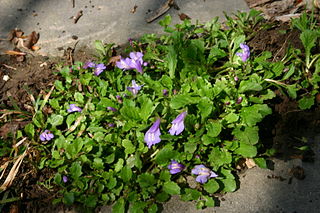
Mazus is a genus of low-growing perennial plants. It has been placed in various plant families including Phrymaceae, Scrophulariaceae, and recently in the family Mazaceae. Consisting of around 30 species, this genus is generally found in damp habitats in lowland or mountain regions of China, Japan, Southeast Asia, Australia and New Zealand.

Hakea epiglottis is a shrub commonly known as beaked hakea or needlebush hakea and is endemic to Tasmania where populations consist of functional unisexual plants. In a 1989 publication by John Wrigley & Murray Fagg states specimens at Wakehurst Place, an annexe of Kew Gardens London are specimens believed to be 60-70 years old measuring 3 m (9.8 ft) high and wide.

Veronica perfoliata, commonly known as digger's speedwell, is a common perennial herb found at higher altitudes in south-eastern Australia. It is a low-growing multi-stemmed plant rising from a woody rootstock. It has rounded blue-grey foliage and sprays of intense violet-blue flowers at the end of arching branches. It is occasionally cultivated as a garden plant.

Lasjia is a genus of five species of trees of the family Proteaceae. Three species grow naturally in northeastern Queensland, Australia and two species in Sulawesi, Indonesia. Descriptively they are the tropical or northern macadamia trees group. Lasjia species characteristically branched compound inflorescences differentiate them from the Macadamia species, of Australia, which have characteristically unbranched compound inflorescences and only grow naturally about 1,000 km (620 mi) further to the south, in southern and central eastern Queensland and in northeastern New South Wales.

Iris potaninii is a species in the genus Iris, it is also in the subgenus of Iris and in the Psammiris section. It is a rhizomatous perennial, from Siberia in Russia, Mongolia and China. It is a dwarf plant, having either subterranean or very small stems, long thin leaves and yellow, or dark violet to purplish blue flowers. It is cultivated as an ornamental plant in temperate regions.
Iris afghanica is a plant species in the genus Iris, it is also in the subgenus Iris and in the section Regelia. It is a rhizomatous perennial, from Afghanistan, with thin bluish-green leaves and creamy yellow or white flowers, that are veined with purple-brown. It has yellow-green or purple beards. Although, in the wild, it can vary in colour and size. It is cultivated as an ornamental plant in temperate regions.
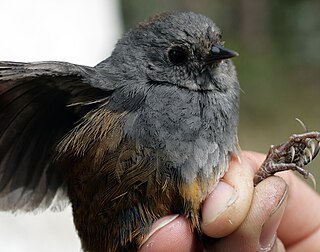
The Perijá tapaculo is a species of passerine bird in the family Rhinocryptidae (tapaculos). Endemic to the Serranía del Perijá mountain range on the Colombia–Venezuela border, the Perijá tapaculo is found at altitudes of 1,600–3,225 metres. Its body is 10 to 12 centimetres long and its tail is about 4 cm (1.6 in) long. Specimens have long been stored in museums, but the species was described only in 2015 based on sixteen specimens found between July 2008 and February 2009. It is considered vulnerable to extinction.
Iris goniocarpa is a plant species in the genus Iris, it is also in the subgenus of Iris and in the section Pseudoregelia. It is a rhizomatous perennial, from China, India, Burma and Bhutan. It has yellow green to dark green, long leaves, slender stem and, one flower between blue, lavender-blue, lilac, blue-violet or blue-purple. It is cultivated as an ornamental plant in temperate regions.

Hakea lissosperma, commonly known as needle bush and mountain needlewood, is a species of Hakea native to parts of south eastern Australia.
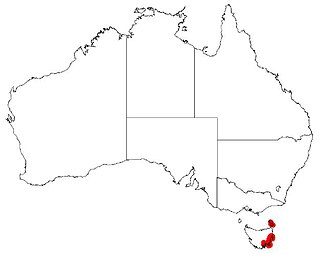
Hakea megadenia is a shrub or tree of the family Proteacea endemic to an area along the east coast of Tasmania and the Furneaux Island group off the coast of Tasmania.
Iris meda is a species in the genus Iris, it is also in the subgenus of Iris and in the Oncocyclus section. It is from the desert mountains and hills of Persia and has long grey-green leaves with cream, pale yellow or yellow flowers, which have purple or dark brown patches and yellow beards.

Leucospermum glabrum is an evergreen, rounded, upright shrub of up to 2½ m (8 ft) high, that is assigned to the family Proteaceae. It has broad inverted egg-shaped leaves with seven to fourteen teeth near their tips, and oval flower heads of about 8 cm (3.2 in) in diameter, with hairy, orange and carmine-coloured flowers from which long styles with a thickened end emerge, giving the flowerhead as a whole the appearance of a pincushion. It flowers between August and October. Its common name is Outeniqua pincushion in English and Outeniekwa-kreupelhout in Afrikaans. It naturally occurs in a limited area on the south coast of South Africa.
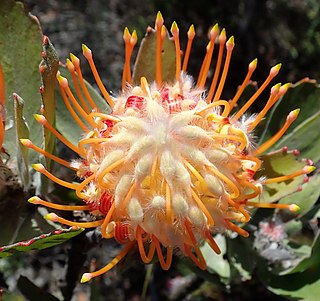
Leucospermum pluridens is a large upright evergreen shrub of up to 3 m (10 ft) high assigned to the family Proteaceae. It has leathery, oblong to wedge-shaped leaves of about 7½ cm long and 2½ cm wide, deeply incised near the tip with seven to ten teeth. It has initially yellow, later carmine coloured flower heads. The 2 cm long bracts have slender, recurved tips. From the center of the perianth emerge long styles that jointly give the impression of a pincushion. It is called Robinson pincushion in English and Robinson-kreupelhout in Afrikaans. Flowers can be found between September and December. It naturally occurs in the south of South Africa.
Leucospermum fulgens is an evergreen, upright shrub of up to 3 m (10 ft) high, from the family Proteaceae. It has hairless and leathery inverted lance-shaped to oblong leaves tipped with mostly three teeth and globe- to egg-shaped flowerheads of 6–8 cm in diameter, that consist of pink to orange, later crimson flowers. From the center of the flowers emerge almost straight styles that jointly give the impression of a pincushion. It is called Potberg pincushion in English. New pink to orange flower heads occur between August and November, but older, crimson heads may persist until January. It is a critically endangered species, only known from one location in the Western Cape province of South Africa.
Leucospermum profugum is an evergreen shrub of up to 8 m (25 ft) in diameter, with at base leafless main branches, that trail over the surrounding vegetation and rock, from the family Proteaceae. It has hairless and leathery inverted lance-shaped to oblong leaves tipped with mostly three or four teeth and flattened egg-shaped flowerheads of 9–12 cm (3.6–4.8 in) in diameter, that consist of initially yellowish orange flowers that later changing to salmon pink. From the center of the flowers emerge almost straight styles that jointly give the impression of a pincushion. It is called Piketberg pincushion in English. Flower heads can be found between late September and December. It is an endangered species, only known from three close locations in the Western Cape province of South Africa.
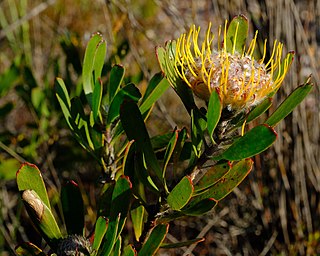
Leucospermum utriculosum is a lax, evergreen, upright and arching shrub of 1–2 m high, from the family Proteaceae. It has hairless inverted lance-shaped to oblong leaves tipped with three to five teeth and globe-shaped to flattened light yellow to coppery flowerheads of 5–8 cm (2.0–3.2 in) in diameter. From the center of the flowers emerge almost straight styles that jointly give the impression of a pincushion. It is called Breede River pincushion in English. Although flower heads may occur on and off between May and March, the peak season is from September to November. It is known from the Western Cape province of South Africa.
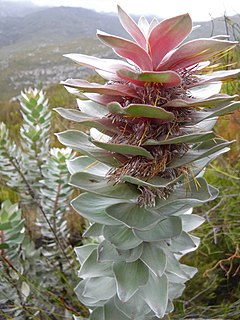
Mimetes argenteus is an evergreen, upright, hardly branching, large shrub of about 2 m high in the family Proteaceae. It has elliptic, silvery leaves, due to a dense covering of silky hairs, that stand out a right angle from the branches. It has cylindric inflorescences of 8–15 cm (3–6 in) long and 10–12 cm (4–5 in) in diameter, crested by smaller silvery pink leaves at an upright angle. These consist of many flower heads, each containing six to nine individual flowers and ar set in the axil of a leaf flushed mauve to carmine. It flowers from March to June. The silver pagoda naturally occurs in the Western Cape province of South Africa. It is called silver pagoda or silver-leaved bottlebrush in English and vaalstompie in Afrikaans.
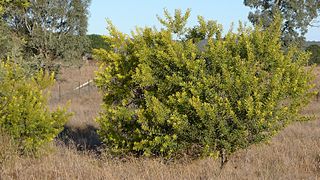
Acacia rubida, commonly known as red stem wattle, red stemmed wattle or red leaved wattle, is a shrub belonging to the genus Acacia and the subgenus Phyllodineae that is native to parts of eastern Australia.

Protea pendula, also known as the nodding sugarbush or arid sugarbush, is a flowering plant of the genus Protea, in the family Proteaceae, which is only found growing in the wild in the Cape Region of South Africa. In the Afrikaans language it is known as knikkopsuikerbossie or ondersteboknopprotea.















